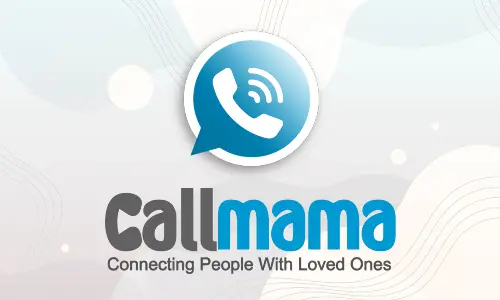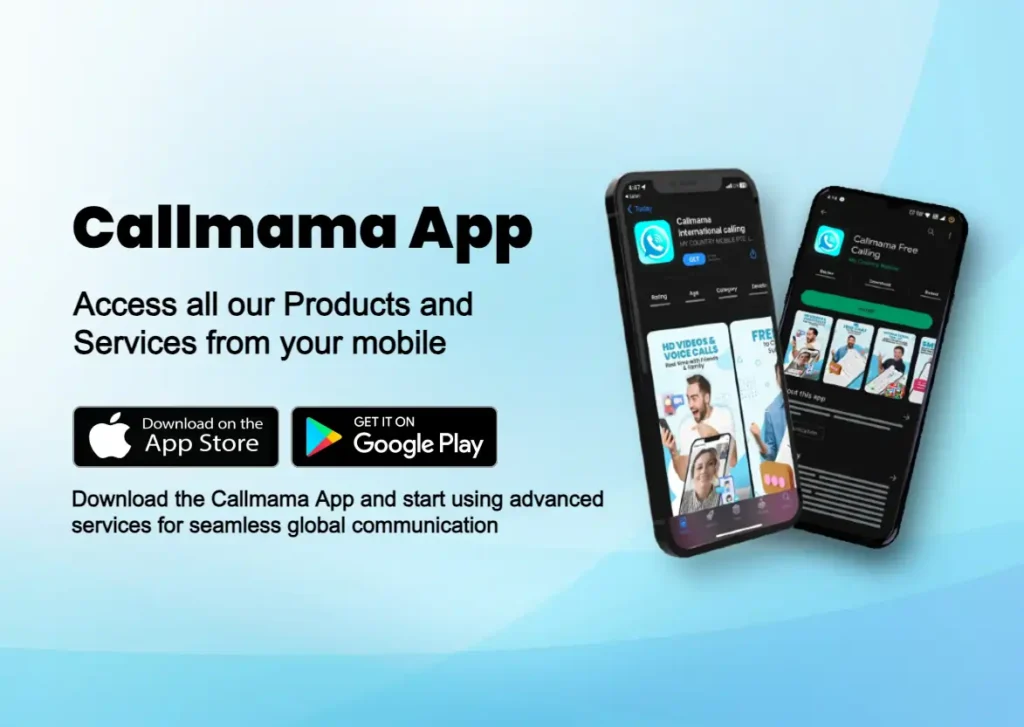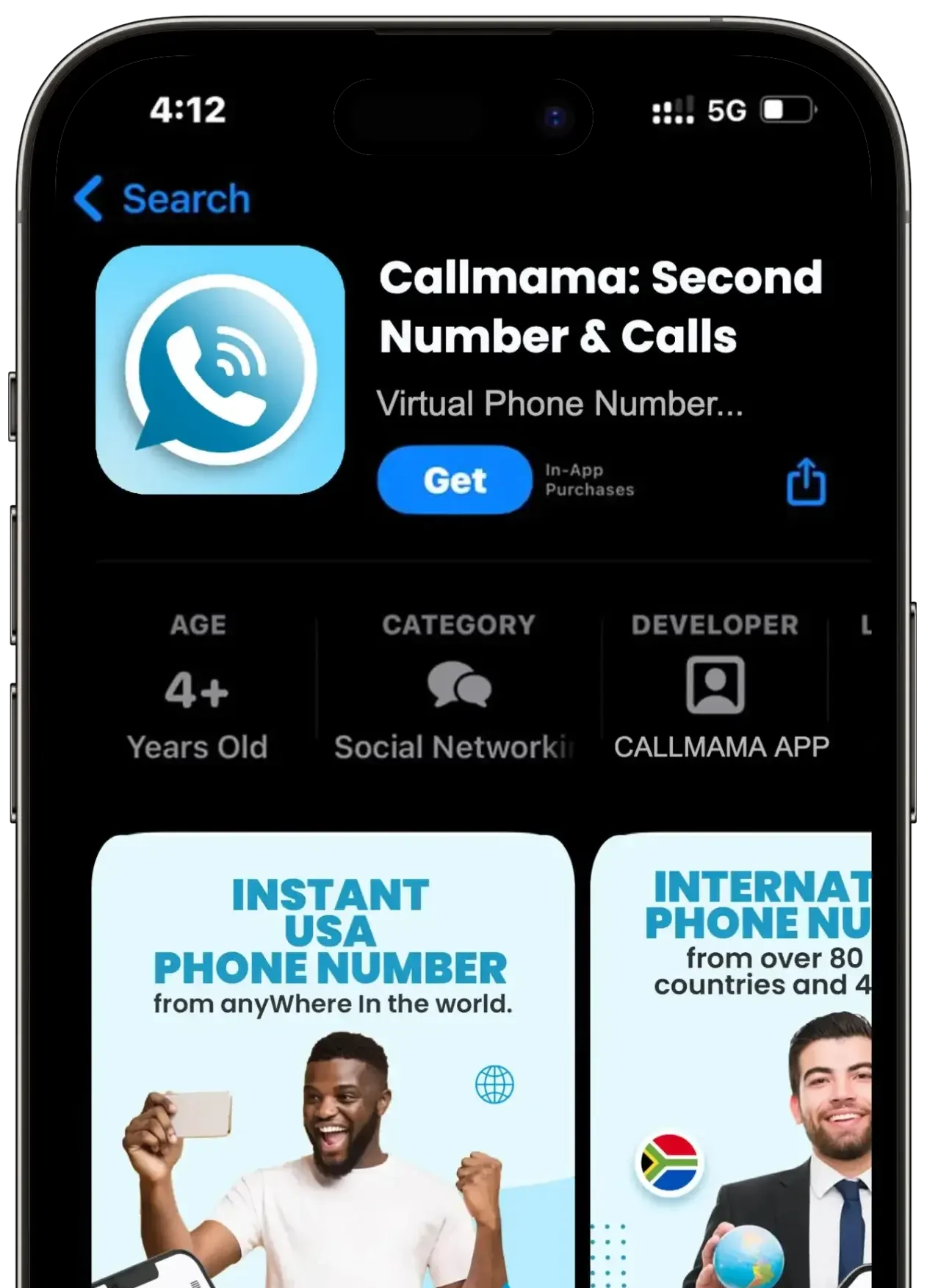Introduction
Calling cards have long been a convenient tool for making affordable phone calls, especially internationally. They work by giving users access to cheaper calling rates through a prepaid balance. Using calling cards on a cell phone can significantly cut down on costs, particularly for international calling. These cards can be physical or virtual, allowing flexibility in how they are used. With a calling card, you can make calls from anywhere without relying solely on your cell phone plan, thus avoiding high roaming fees and preserving your plan’s minutes. This makes international calling cards online an essential tool for travelers and anyone needing to make frequent international calls.
What is a Calling Card?
A calling card, also known as a phone card or telephone card, is a prepaid card used to make long-distance or international phone calls at a reduced rate. These cards provide a cost-effective way to communicate without the need for a traditional phone plan. They can be used from any phone, including landlines, cell phones, and payphones, making them versatile and convenient for users.

Types of Calling Cards
Physical and virtual calling cards offer flexible and convenient solutions for making affordable international and domestic phone calls.
Physical Calling Cards
Physical cards are tangible items that you can buy from various retail stores like convenience stores, grocery stores, or gas stations. These cards come with a printed access number and a PIN, usually hidden under a scratch-off coating. To use a physical card, you need to dial the access number first, then enter the PIN. Once authenticated, you can make your call. The cost of the call is deducted from the prepaid balance on the card. Physical cards are easy to carry and use, making them a popular choice for people who prefer having a physical item.
Virtual Calling Cards
Virtual cards operate similarly to physical cards but do not require a tangible card. These cards are bought online through websites or mobile apps. Once purchased, you receive an access number and a PIN via email or within the app. Virtual cards often offer more convenience because you can manage your balance and usage directly from your smartphone. You simply dial the access number, enter your PIN, and then make your call. Virtual cards are perfect for tech-savvy users who prefer digital solutions and want to avoid carrying an extra card. They also allow easy recharging and tracking of call history through the app or website.
here’s a table comparing:
| Feature | Physical Calling Cards | Virtual Calling Cards |
| Purchase Location | Retail stores (convenience stores, grocery stores) | Online websites or mobile apps |
| Form | Tangible card | Digital (no physical card) |
| Access Number | Printed on the card | Provided via email or within the app |
| PIN | Printed on the card, often under a scratch-off coating | Provided via email or within the app |
| Usage | Dial access number, enter PIN, then make a call | Dial access number, enter PIN, then make a call |
| Balance Management | Check balance by calling a number or checking the card | Manage balance and usage via app or website |
| Convenience | Easy to carry, physical item | Digital, no need to carry a card, accessible on smartphone |
| Recharging | Buy a new card when balance is low | Easily recharge online through the app or website |
| Call History Tracking | Not typically available | Available through app or website |
| Ideal For | Users who prefer a physical item | Tech-savvy users who prefer digital solutions |
How to Use a Calling Card on a Cell Phone
To use a calling card on a cell phone, dial the access number, enter your PIN, then dial the destination number.
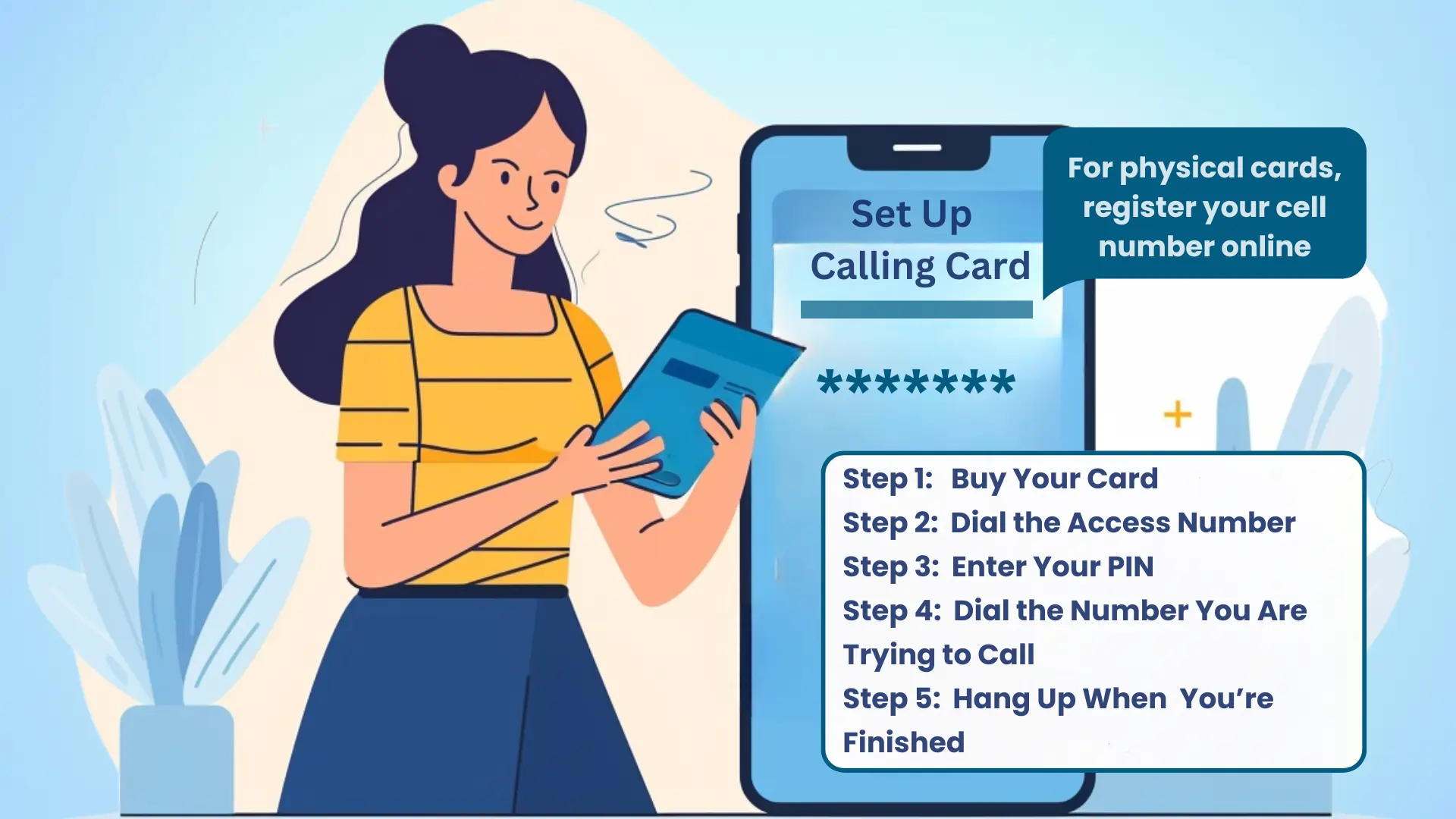
Step 1: Buy Your Card
- Where to Buy (Retail Stores, Online): You can buy calling cards from various retail stores like convenience stores, grocery stores, and gas stations. They are also available online on websites dedicated to these services. When buying online, you can choose from different providers and compare rates.
- Activation Process: After purchasing from a store, the clerk usually activates it for you. If you buy online, it is often activated automatically upon purchase. Ensure that it is activated before attempting to make a call.
- Receiving the Card or Access Details:If you buy a physical card, you will receive a tangible card with the necessary details printed on it. For virtual cards, you will get an email or a notification in the app with your access number and PIN. Make sure to store these details securely.
Step 2: Dial the Access Number
- Toll-Free vs. Local Access Numbers: Each one comes with an access number that you need to dial first. This number could be toll-free, meaning it’s free to dial from most phones, or a local access number, which might incur local call charges. Check for the correct access number and any related costs.
Step 3: Enter Your PIN
- Finding and Entering the PIN: Once you dial the access number, you will be prompted to enter your PIN. For physical cards, the PIN is usually found under a scratch-off coating on the card. For virtual cards, it is provided in the confirmation email or app.
- Security of the PIN: Keep your PIN secure and do not share it with others. If your PIN is compromised, someone else could use your balance. Treat your PIN like a password to protect your account.
Step 4: Dial the Number You Are Trying to Call
- Format for International Calls: To make an international call, dial the destination number after entering your PIN. Begin with the country code, followed by the area code and the local number. For example, to call a number in the UK, you would dial: 011 (international access code) + 44 (country code) + 20 (area code) + local number.
- How the Minutes Are Used: Your call will start using the minutes from your prepaid balance once connected. Listen to the automated prompts; some cards will inform you of the remaining balance before the call connects. This helps you manage your usage effectively.
Step 5: Hang Up When You’re Finished
- Monitoring Call Duration: Pay attention to your call duration to avoid running out of minutes mid-conversation. Some services provide alerts when your balance is low.
- Ending the Call: When you finish your call, simply hang up. Ensure that the call has ended completely to prevent any further deduction from your balance. Double-checking this can save your remaining minutes for future use.
Buying a Calling Card
Buying a calling card is easy; purchase online or at stores like Callmama for affordable international calling from any phone.
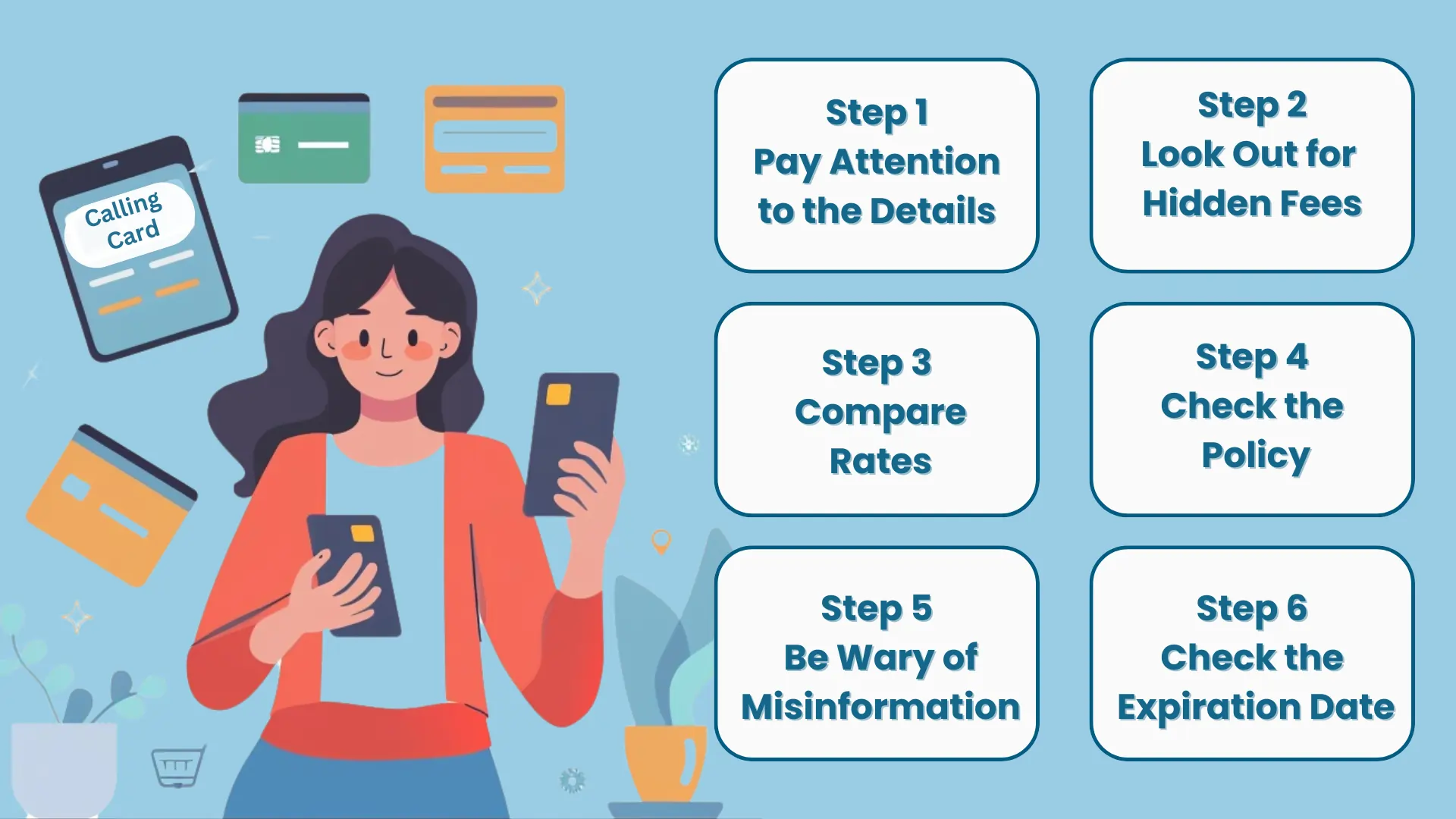
Step 1: Pay Attention to the Details
- Regional vs. International Cards: When choosing a calling card, you need to decide between regional and international cards. Regional cards are designed for calls within a specific area, such as a country or group of countries. International cards, on the other hand, allow you to make telephone calls to various countries worldwide. Ensure the card you choose covers the regions you plan to call.
- Single-Use vs. Multi-Use Cards: Some are single-use, meaning they can only be used for one call or until the balance runs out. Multi-use ones can be used multiple times until the balance is exhausted. Multi-use ones are more convenient if you make frequent calls.
Step 2: Look Out for Hidden Fees
- Types of Fees (Maintenance, Connection, Post-Call, Dialing): Be aware of the various fees that calling cards might have. Maintenance fees are charges deducted regularly, such as weekly. Connection fees are charged each time you connect a call. Post-call fees are deducted after the call ends, and dialing fees may apply each time you dial the access number. These fees can quickly reduce your available minutes.
- Impact of Fees on Usage: Hidden fees can significantly reduce the value of your service. Always read the fine print to understand all potential charges. Choose options with minimal or no hidden fees to maximize your balance.
Step 3: Compare Rates
- Rate Variations by Destination: Calling rates can vary widely depending on the destination. Some cards offer lower rates for specific countries but higher rates for others. Compare the rates for the countries you plan to call most often.
- Checking Rates on Packaging or Company Website: Check the rates provided on the telephone cards packaging or the company’s website. This information helps you estimate how much calling time you’ll get for your money. Make sure the rates align with your calling needs.
Step 4: Check the Policy on International Calling
- Restrictions on Using Calling Services Abroad: Before purchasing a method for international calls, check if there are any restrictions in your destination country. Some countries have regulations that might limit or block the use of certain services. Research this to avoid issues while abroad.
Step 5: Be Wary of Misinformation
- Discrepancies in Advertised vs. Actual Rates: Sometimes the advertised rates on the packaging can differ from the actual rates you get. This discrepancy can lead to unexpected charges. Verify the rates and terms with the provider before purchasing.
- Importance of Customer Service Numbers: Choose a service that provides a customer support number. If you encounter any issues or discrepancies, having access to customer support can help resolve problems quickly.
Step 6: Check the Expiration Date
- Validity Period of the Card: Expiration dates start from the date of purchase or first use. Make sure to check the validity period to avoid losing unused minutes.
- Purchasing Cards as Needed: Avoid buying too many at once, especially if they have a short expiration period. Purchase as you need them to ensure you use the balance before it expires.
Step 7: Consider Buying a Rechargeable Card
- Identifying Rechargeable Cards: Rechargeable options let you add more credit without needing a new purchase. This feature can be cost-effective and convenient for frequent users.
- Recharging Process and Potential Fees: Check how easy it is to recharge the card. Some cards can be recharged online or via a phone call. Be aware of any recharging fees, which can vary between providers. Choose a card with low or no recharging fees to save money.
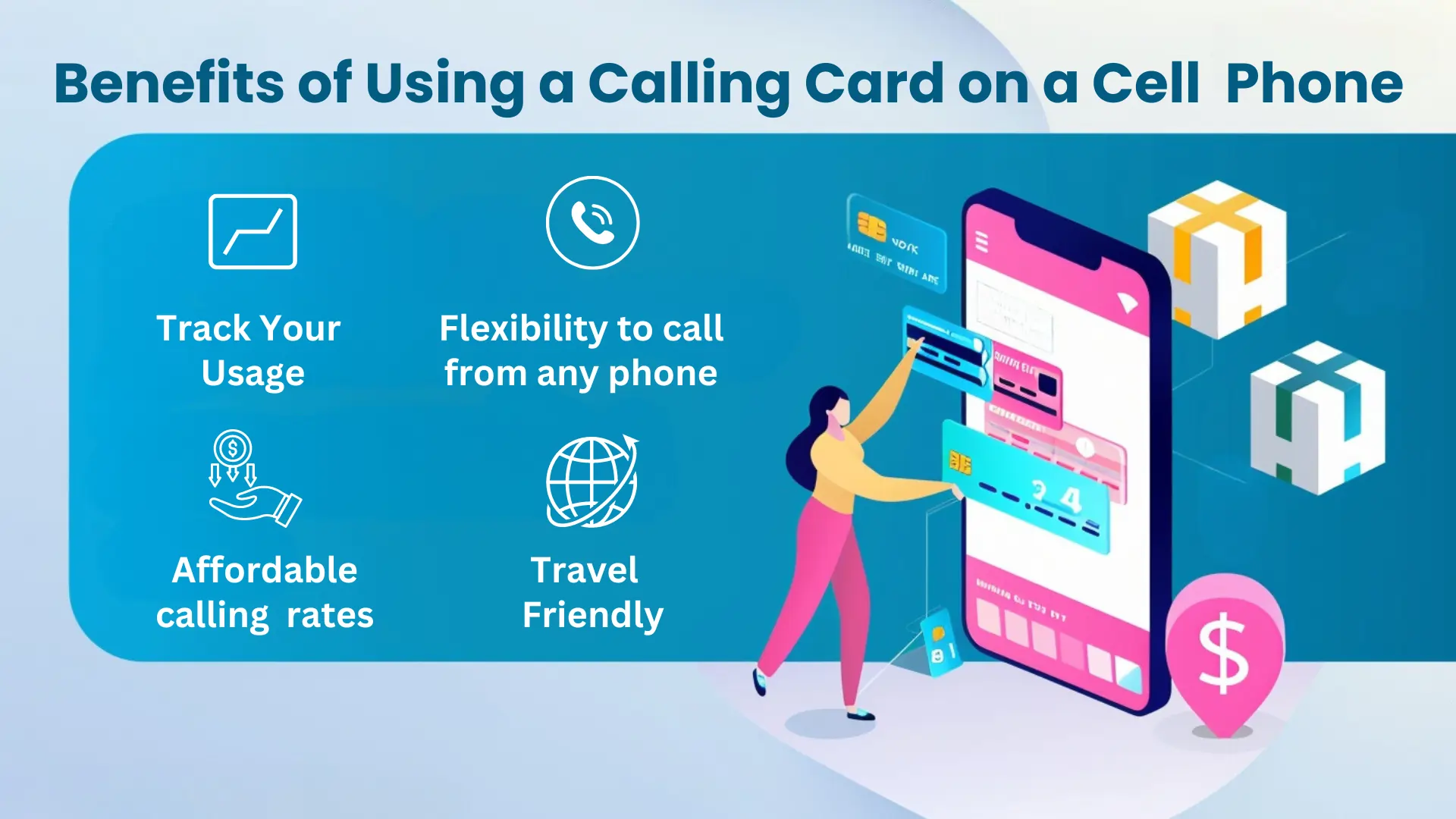
Benefits of Using a Calling Card on a Cell Phone
Using a calling card on a cell phone offers cost savings on international calls, preserves plan minutes, and provides flexible calling options.
- Cost Savings on International Calls: Using a calling card can significantly reduce the cost of international calls. Calling cards typically offer much lower rates than traditional cell phone providers. They leverage bulk wholesale pricing, allowing you to call abroad for just a few cents per minute. This is especially useful for people who make frequent international calls, as it helps to avoid the high charges often associated with regular cell phone plans.
- Flexibility to Call from Any Phone: One of the biggest advantages is flexibility. You can make calls from any phone, not just your cell phone. Whether you are at home, using a landline, at a public payphone, or borrowing a friend’s phone, you can still make calls. This feature is particularly beneficial when traveling, as you can avoid expensive roaming charges by using local phones.
- Preservation of Cell Phone Plan Minutes: When you use this service, the minutes you spend on phone card call do not count against your cell phone plan’s minutes. This is especially helpful if you have a limited number of minutes in your cell phone plan. By using this service for international calls, you can save your cell phone minutes for other necessary calls, ensuring you don’t run out of your plan’s allocated minutes.
- Avoidance of Roaming Charges While Traveling: Roaming charges can be incredibly high when you use your cell phone abroad. To avoid these charges, you can use local access numbers. This way, you can make international calls without worrying about incurring hefty roaming fees. It makes this an essential tool for anyone traveling internationally.
Tips for Saving Money When Using a Cell Phone Calling Card
Compare rates, buy larger credit amounts, use WiFi, and look for promotional deals to maximize savings on calling cards.
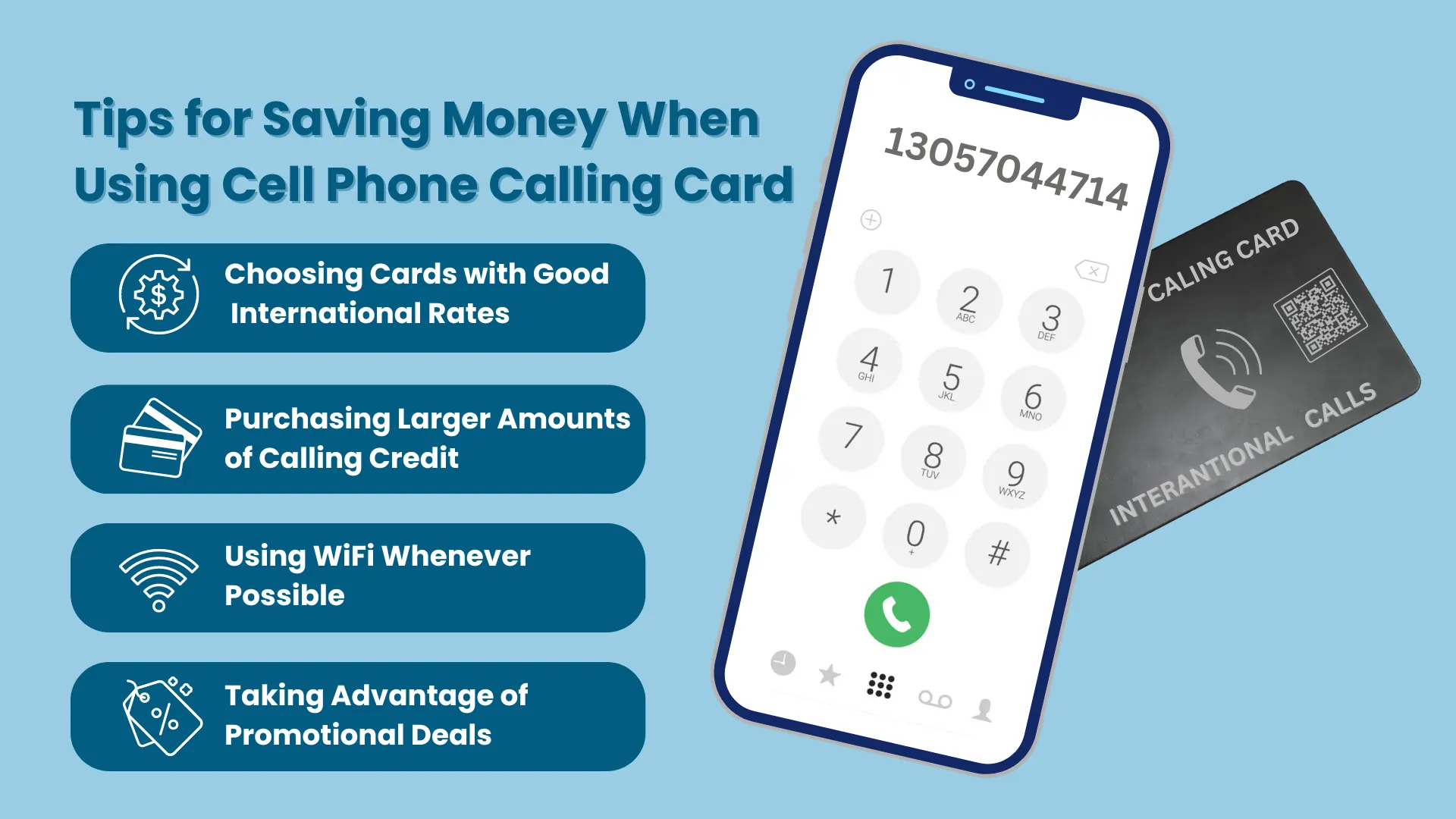
Choosing Cards with Good International Rates
When selecting a service for international calls, it’s important to compare the rates offered by different providers. Some services have better rates for specific countries, which can save you a lot of money if you frequently call those destinations. Check the rates on the provider’s website or packaging to ensure you are getting the best deal for your needs. Choosing a provider with competitive rates will maximize your savings on international calls.
Purchasing Larger Amounts of Calling Credit
Buying calling credit in bulk can often lead to lower per-minute rates. Many providers offer discounts or bonus minutes when you purchase higher denominations of credit. For example, you might get more minutes per dollar when buying $50 of credit compared to $10. This is particularly beneficial if you make frequent international calls, as it reduces the overall cost per call. Always check for these bulk purchase options to get the most value for your money.
Using WiFi Whenever Possible
If your service offers a mobile app or VoIP options, make use of WiFi to place your calls. Calling over WiFi means you won’t use up your cell phone plan’s minutes or incur data charges. This can be especially useful when you are at home, at work, or in any location with a stable WiFi connection. Using WiFi helps to ensure your balance lasts longer, providing more minutes for less money.
Taking Advantage of Promotional Deals and First-Time Offers
Many service providers offer promotional deals and discounts, especially for new customers. These can include bonus minutes, reduced rates for a limited time, or special offers for first-time users. Keep an eye out for these promotions when choosing a service. Signing up for newsletters or checking the provider’s website regularly can help you stay informed about any deals. Taking advantage of these offers can significantly enhance the value you get from the service.
Troubleshooting Common Issues
Check access number and PIN for accuracy. Ensure a stable connection. Contact customer support for persistent issues or balance discrepancies.
Connection Problems
Connection problems can be frustrating when making a call. If you experience difficulties connecting, first check the access number you are dialing. Ensure that you have entered the correct number, including any necessary prefixes or country codes. If the problem persists, try using a different access number if available. Sometimes, local access numbers work better than toll-free numbers. Additionally, ensure that you have a good network signal if you are using a cell phone. Poor reception can also cause connection issues.
Incorrect PIN Entry
Entering your PIN incorrectly can prevent you from making a call. To avoid this, make sure you carefully scratch off the coating to reveal the PIN if using a physical one. For virtual options, double-check the PIN provided in the confirmation email or app. Enter the PIN slowly and accurately to avoid mistakes. If you accidentally lock yourself out after too many incorrect attempts, contact the provider’s customer service for assistance. They can help you reset your PIN or unlock your account.
Balance Discrepancies
If you notice that your balance is lower than expected, there could be a few reasons for this. Hidden fees, such as connection fees or maintenance charges, can reduce your balance without your knowledge. Always read the terms and conditions to be aware of any potential fees. Another reason could be incorrect call duration recording. Check your call history through the provider’s website or app if available. If you still believe there is an error, contact customer service to resolve the issue. They can provide detailed records and help correct any discrepancies.
Comparison with VoIP Service Providers
When making international calls, VoIP (Voice over Internet Protocol) services are a popular alternative to calling cards. Here’s a comparison of some well-known VoIP service providers: Callmama, Skype, WhatsApp, Google Voice and Zoom.
Feature | Callmama | Skype | Google Voice | Zoom | |
Cost | Low international rates, prepaid plans | Low cost, pay-per-minute for calls | Free voice and video calls | Free calls within the US, low international rates | Free for basic calls, paid plans for advanced features |
Ease of Use | Simple app interface, requires internet | User-friendly app, requires internet | Easy to use, requires internet | Integrated with Google account, requires internet | Easy to use, requires internet |
Connection Quality | High quality with good internet | High quality with good internet | High quality with good internet | High quality with good internet | High quality with good internet |
Additional Features | International calling, messaging, caller ID | Video calls, messaging, file sharing | Video calls, messaging, multimedia sharing | Voicemail, SMS, call forwarding | Video calls, screen sharing, webinars |
Device Compatibility | PC, smartphone, tablet | PC, smartphone, tablet, smart TVs | Smartphone, tablet | PC, smartphone, tablet | PC, smartphone, tablet |
Best for | Frequent international callers | Personal and business use | Personal use | Personal and business use | Business use, group meetings |
International Call Rates | Very low rates to many countries | Low rates to landlines and mobiles | N/A (internet-based calling only) | Low rates to landlines and mobiles | N/A (internet-based calling only) |
Offline Functionality | No | No | No | Limited (requires internet for most features) | No |
Each VoIP service provider has its strengths and is suitable for different use cases. Callmama stands out for its very low international rates, making it perfect for frequent international callers. Skype and Google Voice offer low-cost international calling cards online to landlines and mobiles, making them versatile options for various needs. WhatsApp is excellent for free internet-based calls and messaging, ideal for personal use. Zoom excels in business environments with its robust video conferencing and collaboration tools. Choosing the right VoIP service depends on your specific needs, device compatibility, and whether you require calling capabilities beyond internet-based communication.
Security Tips for Using a Calling Card on Your Cell Phone
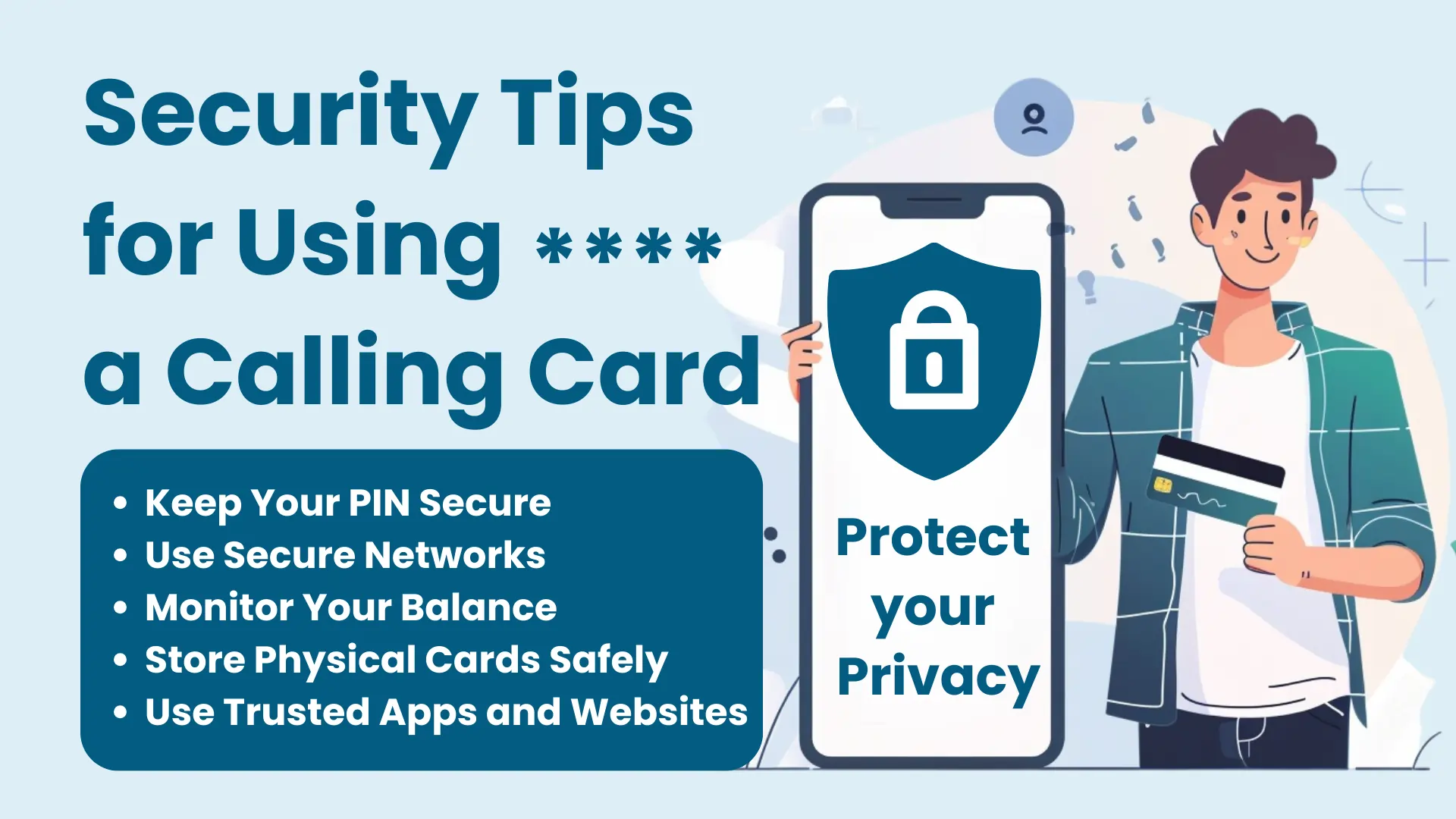
Using your cell phone for calls is convenient and cost-effective, but it’s important to protect your information to avoid misuse. Here are some essential security tips to keep your details safe and steps to take if your information is compromised.
Protecting Your Calling Card Information
Keep Your PIN Secure
- Do not share your PIN with anyone.
- Memorize your PIN and avoid writing it down where it can be easily found.
- Scratch off the PIN coating only when you are ready to use it, and dispose of the scratched-off material securely.
Use Secure Networks
- When entering your PIN and card number online or in an app, ensure you are on a secure network.
- Avoid using public WiFi networks for entering sensitive information.
Monitor Your Balance Regularly
- Regularly check your card balance and usage history to spot any unauthorized activity.
- Set up alerts if your calling card provider offers this feature.
Store Physical Cards Safely
- Keep physical calling cards in a safe place, away from prying eyes.
- If possible, register your physical card online to track its usage and balance.
Use Trusted Apps and Websites
- Only use official apps and websites from your calling card provider.
- Be cautious of phishing scams that mimic legitimate providers to steal your information.
What to Do if Card Details Are Compromised
Immediate Actions
- As soon as you suspect your card details have been compromised, contact the calling card provider’s customer service.
- Provide them with the necessary information to block your card and prevent further misuse.
Report Unauthorized Usage
- Inform your provider about any unauthorized calls or transactions.
- Request a detailed statement to identify all unauthorized usage.
Request a New Card
- Ask your provider to issue a new calling card with a different PIN and card number.
- Transfer any remaining balance from the compromised card to the new one, if possible.
Change Passwords
- If you use an online account to manage your calling card, change your password immediately.
- Use a strong, unique password and consider enabling two-factor authentication if available.
Monitor for Further Issues
- Keep an eye on your calling card account for any further suspicious activity.
- Consider setting up additional security measures such as alerts for unusual activity.
Latest Trends in the Calling Card Industry
The industry is evolving with new technologies and trends to meet the changing needs of consumers. These advancements make communication methods more convenient, efficient, and versatile.
Virtual Calling Cards
One of the significant trends is the rise of virtual alternatives. Unlike traditional physical ones, these exist solely in digital form. They are purchased online and managed through apps or websites. This trend is driven by the increasing use of smartphones and the convenience of not having to carry anything physical. Virtual alternatives often offer features like balance tracking, instant recharges, and usage history, all accessible from a mobile app.
Integration with Mobile Apps
Many service providers are now integrating their services with mobile apps. These apps allow users to make calls directly from their smartphones without dialing an access number or entering a PIN each time. The app handles the authentication process, making it seamless for the user. Additionally, these apps often include features like contact management, call logs, and real-time balance updates.
Improved Security Measures
Security is a growing concern, and calling card providers are implementing better security measures to protect users. Two-factor authentication (2FA) is becoming standard, adding an extra layer of security. Users must verify their identity through an additional step, such as a code sent to their phone, before accessing their account. This helps prevent unauthorized use of calling card balances.
Competitive Rates and Promotions
To stay competitive, many providers are offering better rates and attractive promotions. Some offer bonus minutes or extra credit on the first purchase or when recharging a phone card. There are also frequent discounts on international rates to popular destinations. This trend is beneficial for consumers looking for the best value for their money.
Enhanced Customer Support
Customer support is improving with more providers offering 24/7 support through various channels like chat, email, and phone. This ensures that users can get help whenever they need it, enhancing the overall user experience. Some providers also offer detailed FAQs and tutorials on their websites to assist users in resolving common issues on their own.
Eco-Friendly Options
Sustainability is becoming important in the calling card industry. Virtual cards eliminate the need for plastic cards, reducing environmental impact. Additionally, some providers are using recycled materials for physical cards and offering electronic receipts to minimize paper use.
Hybrid Calling Solutions
Hybrid solutions that combine VoIP and traditional calling card features are emerging. These solutions allow users to make calls over the internet where available, falling back on traditional phone lines when internet access is unreliable. This flexibility ensures consistent call quality and connectivity.
Data-Driven Insights
Providers are leveraging data analytics to offer personalized services. By analyzing usage patterns, they can recommend calling plans that best suit individual needs, offer targeted promotions, and improve customer retention. This trend is enhancing the user experience by making services more tailored and efficient.
the latest trends in the industry focus on improving convenience, security, and customer satisfaction through technological advancements and innovative services. Whether through virtual options, mobile app integrations, or enhanced security measures, these trends are reshaping how users interact and making international communication more accessible and cost-effective.
Conclusion
Using calling cards on cell phones offers numerous benefits, including cost savings on international calls, flexibility to call from any phone, and the preservation of cell phone plan minutes. By following simple steps—buying the card, dialing the access number, entering the PIN, and making the call—users can easily make affordable international calls. Additionally, staying informed about hidden fees, comparing rates, and understanding security measures ensures a smooth experience.
Incorporating the latest trends such as virtual alternatives, mobile app integration, and improved security measures further enhances the convenience and efficiency of using these services. These advancements, along with competitive rates and eco-friendly options, make these services a practical choice for international communication. Overall, they remain a valuable tool for anyone looking to manage their phone expenses while staying connected globally.
FAQs
What is a calling card?
A phone card, also known as a telephone card, is a prepaid card used for making international calls. You can buy phone cards online or at retail locations like Walmart. These cards provide a cost-effective way to make calls from cell phones, landlines, or payphones.
How do I use a calling card for international calls?
To make international calls, you typically dial an access number, enter your PIN, and then dial the number you wish to reach. This process is straightforward and similar across different services, whether you are using your mobile phone or an online service.
Where can I buy a calling card?
You can make international calls by purchasing them online or at physical stores like Walmart. Many people prefer buying them online because it offers a wide selection of options, including the best deals and various choices.
Are there calling cards specifically for cell phones?
Yes, there are cell phone cards specifically designed for mobile use. These include cell phone prepaid cards and international phone cards for mobile phones. Using a cell phone with a phone card is a convenient way to manage your international calling expenses.
How do I choose the best international calling card?
To choose the best international phone card, consider factors like call rates, connection fees, and the reputation of the provider. Online reviews and comparisons can help you find the best option for your needs.
Can I use a calling card with my cell phone?
Absolutely, you can use your cell phone for international calls. Many people use prepaid options to save money on these calls. There are specific plans and prepaid options that make this easy and cost-effective.
What are the benefits of using a calling card?
Using these cards offers several benefits, including cost savings on international calls, convenience, and the ability to control your spending. Online cards and phone cards from retailers like Walmart provide flexible options for various needs.
How does a calling card work with services like Boss Revolution?
With services like Boss Revolution, you can make a call by following the specific instructions provided by the service. Typically, you dial an access number, enter your PIN, and make your call. Many users buy phone cards online to use with such services.
Can I use a calling card to call the U.S. from India?
Yes, you can call the U.S. from India. By purchasing international phone cards online or at stores, you can make affordable calls to the U.S. using your cell phone or landline. This is particularly useful for frequent travelers and expatriates.
What should I look for when buying a calling card?
When buying a phone card, consider factors like call rates, connection fees, and user reviews. Purchasing phone cards online can provide more variety and better deals. You can also check out phone cards and business card options at places like Walmart for additional choices.

